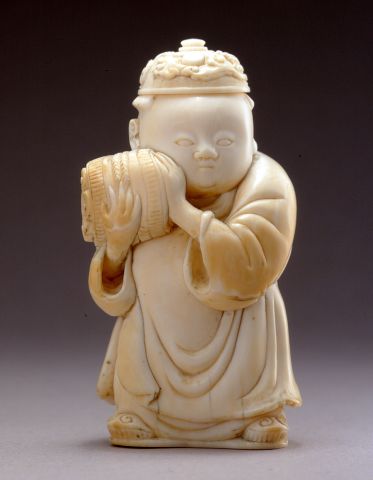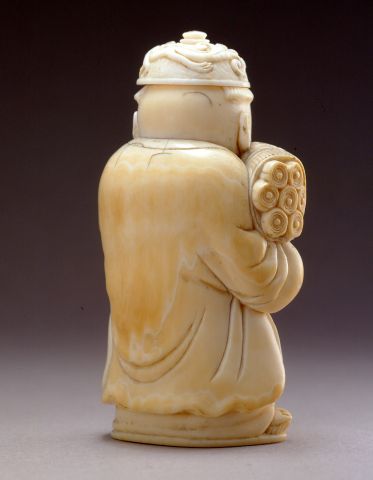

Bottle ID: 287
CHUBBY-FACED ATTENDANT
Date: 1875-1920
Height: 64 mm
Ivory, carved as a figure in the form of a snub-nosed chubby-faced youth wearing loose robes and clutching a bundle of seven scrolls to his right shoulder, his ruyi-decorated shoes poking out from under his robes; his face detailed and with two small tufts of hair appearing from under the side of his cap which is formed by the original stopper, the cap carved in low relief with a dragon chasing a sacred pearl on a stippled ground centered by a short finial, the base with a four character Qianlong nianzhi seal mark, but not of the period, the ivory of an attractive color with soft creamy patina.
Similar Examples:
Crane Collection no. 359
Parke-Bernet Galleries Inc., Fine Snuff Bottles from The Collection of Mrs. Elmer A. Claar, Part one, December 2, 1969, lot 55.
Stevens, Bob C. The Collector's Book of Snuff Bottles, 1976, p. 206, no. 789.
Moss, Hugh, Victor Graham and Ka Bo Tsang. A Treasury of Chinese Snuff Bottles - The Mary and George Bloch Collection, Vol. 7, Part 1, pp. 211-213, no. 1553.
Provenance:
Clare Lawrence Ltd.
Christie's, New York, September 21, 1995, lot 354
This small group of ivory figural bottles are generally accepted as Japanese, probably produced for both the Chinese market and Western markets and often appear with their original stoppers carved either as the head of the figure or, as in this case, the hat. This is not to decry their quality as they are very well carved with great attention to detail and usually from very good pieces of ivory, evidenced by the creamy patination that they acquire over years of dedicated handling. In contrast to this Japanese example is the standing ivory figure of Liu Hai in the Bloch Collection that the authors of “Treasury 7” argue is Chinese and in all likelihood produced for its original owner, Sir Victor Sassoon who was actively collecting ivory “antiques” in China in the early 20th century. Whether Sir Victor Sassoon had access to the Japanese group while he was in either Beijing or Shanghai is a moot point, but it is certainly interesting that similar groups of bottles were being produced in both countries.
< Back to full list
 English
English 中文
中文